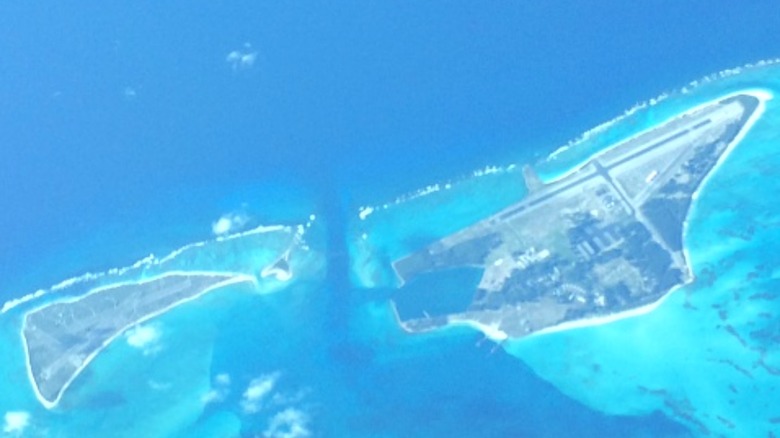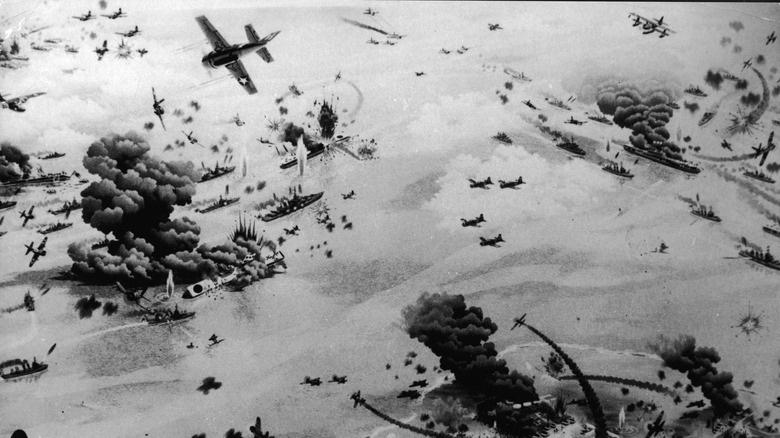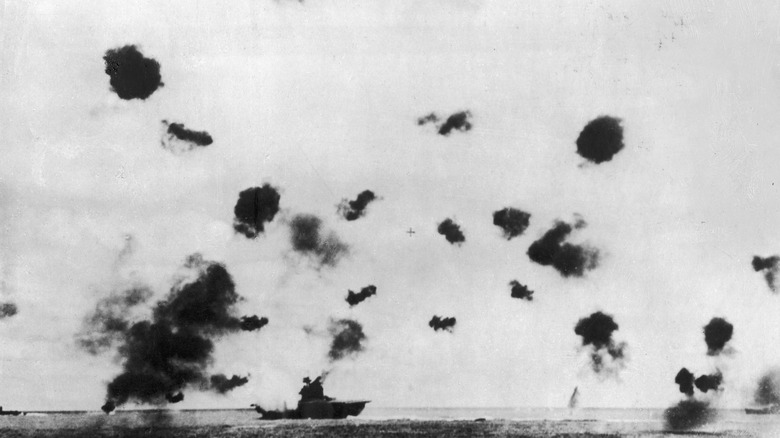How Important Is The Midway Atoll, America's Unsinkable Aircraft Carrier?
While America's massive fleet of aircraft carriers is difficult to sink, they are sadly not unsinkable. The title of this article refers to Midway Atoll as an "Unsinkable Aircraft Carrier," but as many know, Midway isn't a ship — it's an island. The term "Unsinkable Aircraft Carrier" refers to any island that is primarily used for the launching and recovery of military aircraft, and Midway Island is arguably one of the most important in U.S. history.
For all intents and purposes, Midway Atoll was an immobile aircraft carrier that cannot be sunk without some serious global warming or other natural catastrophe. This is one of the main reasons the U.S. utilized Midway during World War II. The island presented the perfect location to build a forward operating airbase in the waters between the Empire of Japan and the coastal United States. One of the war's most decisive battles took place there, but it's no longer used for military purposes.
Midway Island was handed over to the National Park Service in 1996, and today, it's a fully functioning bird sanctuary and national memorial. The Commercial Pacific Cable Company also utilizes the island, but it no longer supports U.S. military operations. Today, Midway isn't an important location for the U.S.' military might, but had the nation not held Midway during the June 4-7, 1942, Battle of Midway, World War II may have ended differently, making the Midway Atoll one of the most important Unsinkable Aircraft Carriers ever utilized in war.
The Battle of Midway
Six months after Japanese forces attacked Pearl Harbor, Midway Atoll became the site of yet another Japanese assault. The Battle of Midway was one of the most important Pacific engagements during the war, and it was massive. Japan brought four fleet carriers, two battleships, two heavy cruisers, a light cruiser, 12 destroyers, and 276 carrier-based aircraft. Their support vessels included another four heavy cruisers and two destroyers.
The Americans had fewer vessels compared to the Japanese force. The U.S. had three fleet carriers, seven heavy cruisers, a light cruiser, 15 destroyers, 16 submarines, several small support craft, and 276 carrier-based aircraft. Something the Americans had over the Japanese was a force of 127 aircraft at Midway, giving U.S. forces air superiority via sheer numbers. The resulting battle cost Japan all of its carriers, 248 aircraft, 3,057 men, and many more ships.
Compared to the Japanese, the American losses were significantly less. 150 aircraft were destroyed along with a carrier and destroyer that were sunk, and 307 men who were lost. The battle turned the tide of Pacific operations throughout the war and gave the Americans an advantage over Japan. While much of the U.S. fleet was devastated at Pearl Harbor, the carriers were elsewhere, and after the Battle of Midway, Japan suffered the loss of its carrier fleet. While Japan built a few more before the war ended, Americans largely retained seaborne air superiority via its fleet of carriers.
Midway's impact on WWII
Midway Atoll proved its worth at the Battle of Midway by offering the Americans a much-needed victory over Japan. On top of that, American forces also took down all four carriers that assaulted Pearl Harbor six months earlier. The battle was a tactical and strategic victory, but more than that, it was a moral victory against the naval forces of a nation that launched a surprise attack on an American port.
The battle changed the United States' strategy in the region, giving the States a strategic advantage over Japan. This led to the Battle of Guadalcanal, which was also a significant turning point in the war. Losses at Midway impacted Japanese military readiness after losing thousands of veterans with combat experience. Given the disparity in fleet strengths engaged at the Battle of Midway, it's unlikely the Americans would have been as successful as they were without the atoll providing support.
With Midway Atoll providing support, the Americans were able to land aircraft that would have been lost after the sinking of the USS Yorktown (CV-10). With this victory, Midway became one of the most important tactical and strategic Unsinkable Aircraft Carriers of Pacific real estate, having helped the U.S. ultimately defeat the Empire of Japan.


